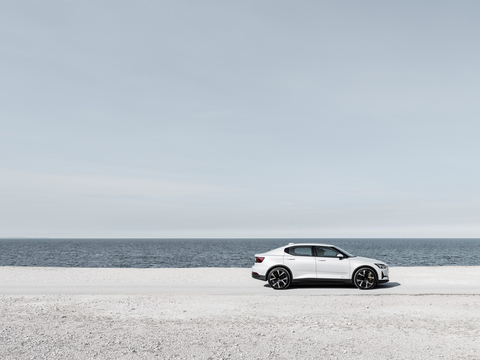GOTHENBURG, Sweden--(BUSINESS WIRE)--Polestar (Nasdaq: PSNY) has published its third Annual Sustainability Report, which outlines initiatives and performance on environmental, social and governance matters in 2022.
The Swedish EV-maker confirms it has reduced relative CO2e-emissions per car sold by eight percent compared to 2021 levels, and this during a year of record global volume growth, as the company delivered nearly 51,500 cars in 2022, an increase of 80 percent since 2021. While absolute emissions have increased as a result of the scale-up, relative emissions on a per-unit-basis have reduced by 13 percent since 2020. This is the second consecutive year the company combined rapid growth with carbon cuts. This puts Polestar on track towards its goals of halving relative emissions by 2030.
The reductions come down to several factors, for example reduced average transports, high sales in markets with more renewable energy on grids, but also ongoing updates, pushed through by Polestar’s sustainability team within its car programs. One example of this is a change of supplier providing aluminum for the wheels and battery trays for Polestar 2, where a change to a hydro-powered smelter resulted in a 1.2 tonne reduction per car. Other contributing factors are the factory where Polestar 2 is built now running on 100 percent renewable electricity, as well as a diversified product portfolio with a larger share of single motor vehicles which have a lower energy demand during production.
Fredrika Klarén, Head of Sustainability at Polestar, says: “We wear our emissions on our sleeve – measuring and scrutinizing every detail ensures we keep our eye on the ball. Electrification alone is not enough and pure EV-makers like Polestar have a lot of work ahead of us. Our focus remains unchanged as we double down on cutting emissions in our supply chain.”
In addition to their environmental footprint from production, EVs also come with a social footprint. Polestar uses blockchain to trace risk materials back to the mine, mitigating social and environmental risks in complex supply chains. Material traceability is now increased to include cobalt, mica, lithium, nickel as well as leather and wool.
The Polestar 0 project, the company’s goal to create a truly climate-neutral car by 2030, has now been joined by over 20 leading players from various industries, all focused on finding solutions to eliminate CO2e and re-think processes, instead of relying on misleading offsetting schemes.
During 2022 Polestar teamed up with Circle Economy and STENA Recycling to measure the company’s impact and set a circularity baseline, from which work will be done to improve raw material consumption, biodiversity and recyclability.
Polestar also received additional certification in February 2023 as it was rated a low-risk 17 by Sustainalytics.
Find the 2022 sustainability report here.
Separately, Polestar now expects to file its Annual Report on Form 20-F with the U.S. Securities and Exchange Commission on or before May 1, 2023.
Notes to editors
- Polestar’s sustainability report is created according to 2021 GRI Standards, the European Union’s Non-Financial Reporting Directive (as implemented by the Swedish Annual Accounts Act’s requirements on the statutory sustainability report) and details disclosures in line with the Taskforce on Climate-related Financial Disclosures (TCFD).
- Polestar’s partnership with Circulor provides a unique transparency precedent for the automotive sector. Blockchain technology gives Polestar the ability to track a wide range of raw materials used throughout vehicle and parts production, particularly any risk materials that may have significant environmental impact or pose human rights challenges. Circulor provides a private blockchain that doesn’t come with the heavy carbon emissions of public blockchains.
- The Polestar 0 project is Polestar's goal of creating a truly climate-neutral car by 2030, which was announced in the company’s first annual review, published in April 2021. The Polestar 0 project aims to cut carbon emissions by changing the way that cars are made, rather than using traditional processes and then planting trees to offset CO2e. The approach aims to encompass collaboration across the entire development process and value chain, from suppliers to retailers. The project targets what Polestar can measure and control: zero carbon emissions in the production of the car, delivery to customer, and end-of-life. The use phase of an electric car can already today be close to climate-neutral if the car is charged with renewable energy. Polestar is firmly dedicated to the Polestar 0 project and have assigned an internal taskforce as well as an important R&D-budget, however, this is not a normal car project and the usual delivery guarantees cannot be given. The Polestar 0 project is a moonshot goal, aimed at challenging ourselves, the industry and intended to create a sense of urgency. We want to galvanize innovation and exponential thinking, convinced it will lead to big leaps in the right direction.
About Polestar
Polestar (Nasdaq: PSNY) is the Swedish electric performance car brand determined to improve society by using design and technology to accelerate the shift to sustainable mobility. Headquartered in Gothenburg, Sweden, its cars are available online in 27 markets globally across North America, Europe and Asia Pacific. The company plans to create a truly climate-neutral production car, without offsetting, by 2030.
Polestar 2 launched in 2019 as the electric performance fastback with avant-garde Scandinavian design and up to 350 kW. Polestar 3 launched in late 2022 as the SUV for the electric age – a large high-performance SUV that delivers sports car dynamics with a low stance and spacious interior. Polestar plans to release three more electric performance vehicles through to 2026.
Forward-Looking Statements
Certain statements in this press release (“Press Release”) may be considered “forward-looking statements” as defined in the Private Securities Litigation Reform Act of 1995. Forward-looking statements generally relate to future events or the future financial or operating performance of Polestar. For example, projections of revenue, volumes and other financial or operating metrics are forward-looking statements. In some cases, you can identify forward-looking statements by terminology such as “may”, “should”, “expect”, “intend”, “will”, “estimate”, “anticipate”, “believe”, “predict”, “potential”, “forecast”, “plan”, “seek”, “future”, “propose” or “continue”, or the negatives of these terms or variations of them or similar terminology. Such forward-looking statements are subject to risks, uncertainties, and other factors which could cause actual results to differ materially from those expressed or implied by such forward looking statements.
These forward-looking statements are based upon estimates and assumptions that, while considered reasonable by Polestar and its management, as the case may be, are inherently uncertain. Factors that may cause actual results to differ materially from current expectations include, but are not limited to: (1) Polestar’s ability to maintain agreements or partnerships with its strategic partners, Volvo Cars and Geely, and to develop new agreements or partnerships; (2) Polestar’s ability to maintain relationships with its existing suppliers, and source new suppliers for its critical components, and to complete building out its supply chain, while effectively managing the risks due to such relationships; (3) Polestar’s reliance on its partnerships with vehicle charging networks to provide charging solutions for its vehicles and its reliance on strategic partners for servicing its vehicles and their integrated software; (4) Polestar’s reliance on its partners to manufacture vehicles at a high volume, some of which have limited experience in producing electric vehicles, and on the allocation of sufficient production capacity to Polestar by its partners in order for Polestar to be able to increase its vehicle production capacities; (5) competition, the ability of Polestar to grow and manage growth profitably, maintain relationships with customers and suppliers and retain its management and key employees; (6) Polestar’s estimates of expenses and profitability; (7) increases in costs, disruption of supply or shortage of materials, in particular for lithium-ion cells or semiconductors; (8) the possibility that Polestar may be adversely affected by other economic, business, and/or competitive factors; (9) the effects of competition and the high barriers to entry in the automotive industry, and the pace and depth of electric vehicle adoption generally on Polestar’s future business; (10) changes in regulatory requirements, governmental incentives and fuel and energy prices; (11) the outcome of any legal proceedings that may be instituted against Polestar or others; (12) the ability to meet stock exchange listing standards; (13) risks associated with changes in applicable laws or regulations and with Polestar’s international operations; (14) Polestar’s ability to establish its brand and capture additional market share, and the risks associated with negative press or reputational harm, including from lithium-ion battery cells catching fire or venting smoke; (15) delays in the design, manufacture, launch and financing of Polestar’s vehicles and Polestar’s reliance on a limited number of vehicle models to generate revenues; (16) Polestar’s ability to continuously and rapidly innovate, develop and market new products; (17) risks related to future market adoption of Polestar’s offerings; (18) risks related to Polestar’s distribution model; (19) the impact of the global COVID-19 pandemic, inflation, interest rate changes, the ongoing conflict between Ukraine and Russia, supply chain disruptions and logistical constraints on Polestar, Polestar’s projected results of operations, financial performance or other financial and operational metrics, or on any of the foregoing risks; and (20) other risks and uncertainties set forth in the sections entitled “Risk Factors” and “Cautionary Note Regarding Forward-Looking Statements” in Polestar’s Form 20-F, and other documents filed, or to be filed, with the SEC by Polestar. There may be additional risks that Polestar presently does not know or that Polestar currently believes are immaterial that could also cause actual results to differ from those contained in the forward-looking statements.
Nothing in this Press Release should be regarded as a representation by any person that the forward-looking statements set forth herein will be achieved or that any of the contemplated results of such forward-looking statements will be achieved. You should not place undue reliance on forward-looking statements, which speak only as of the date they are made. Polestar assumes no obligation to update these forward-looking statements, even if new information becomes available in the future.




